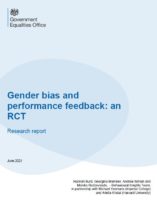In order to achieve gender equality in the workplace there needs to be a focus on reducing bias in, and improving the quality of, performance feedback for women.
In this study we analysed the language used in 360 degree feedback reviews carried out between 2018 and 2019 for 4,328 senior managers in a large UK public sector organisation.
We ran a randomised controlled trial which compared feedback provided by reviewers who saw either:
- A ‘business-as-usual’ feedback form
- A treatment form, which encouraged reviewers to provide specific examples in their feedback and to include feedback on both relationship-oriented and task-oriented skills. This form also switched one of the forms quantitative ratings from asking about “visibility” (in the business-as-usual version) to asking about “accessibility”.
Natural language processing and dictionary methods were used to provide insights into the use of gender-stereotyped language in feedback and how the specificity of feedback differed across genders. A machine learning model was also used to predict the review subject’s gender based on the language in the review, analysing whether predictability of gender differed between the treatment and the control conditions.
The intervention did not systematically increase the specificity of feedback, which may be due to the treatment condition instructions attempting to fulfil additional aims – notably increasing actionability and also reducing gender bias. The business-as-usual approach already asked people to provide a defined number of examples, so we saw a ceiling of specificity being reached.
We also found exploratory evidence that women were more likely than men to receive tentative feedback. This suggests that some gender stereotypes may persist. In particular, feedback for women seemed to be more positive and less direct, even controlling for performance quality, suggesting that development may not be prioritised for female recipients, which is consistent with the literature on benevolent sexism.
Finally, we found some interesting, albeit tentative, results on asking people to rate someone on their ‘visibility’ versus ‘accessibility’ which suggest that ‘accessible’ correlates better with overall job performance than ‘visible’. We speculate that this distinction seems particularly important for remote and flexible work, where accessibility may be more achievable than visibility. We encourage employers to avoid questions of job ‘inputs’ (i.e. hours worked or location of work) and instead to focus on ‘outputs’ (i.e. objectives met, tasks delivered, team successes).
This piece of work was part of the Gender & Behavioural Insights Programme, funded by The Government Equalities Office. Read more of the programme’s insights for equality here.






